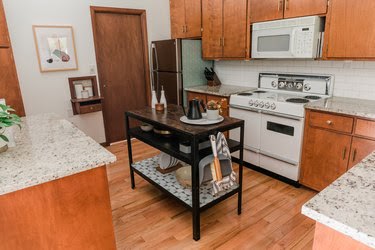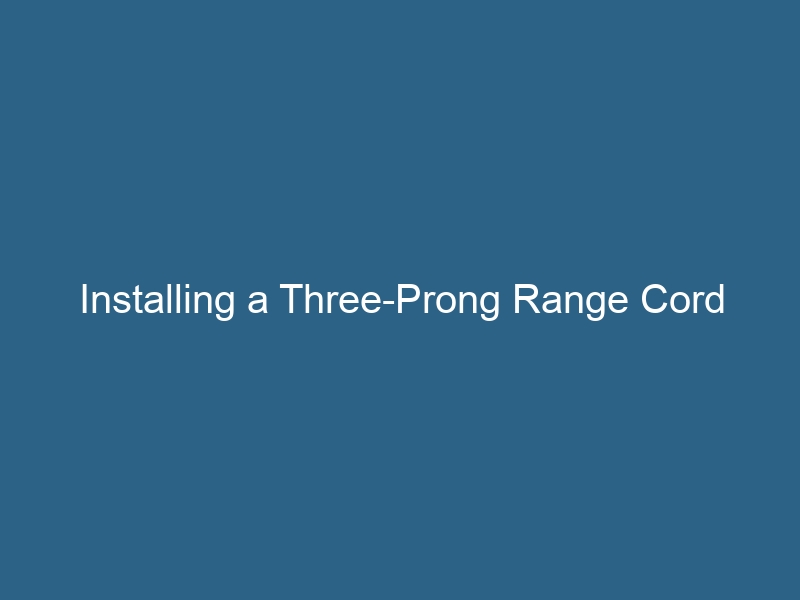Quck answer
To install a three-prong range cord, follow these steps:
1. Disconnect the power. Turn off the circuit breaker or unplug the range from the wall.
2. Remove the old cord. Unscrew the terminal screws and detach the old cord from the range.
3. Prepare the new cord. Strip the insulation from the wires, exposing about 1/2 inch of bare wire.
4. Connect the new cord. Attach the wires to the corresponding terminals on the range, following the color coding (black to black, white to white, and green to green).
5. Tighten the terminal screws. Ensure a secure connection by tightening the screws.
6. Test the connection. Plug in the range, turn on the power, and test that it is working properly.
By following these steps, you can easily install a three-prong range cord and safely power your range.
Imagine a common situation where you need to replace your old electric range with a new model, but the new range comes with a four-prong cord and your house has an older-style three-slot outlet. Or perhaps you’ve moved to a new house and the electric range you brought with you has a cord that doesn’t fit the outlet in the new house. In both cases, you can solve this problem by replacing the four-prong cord with a three-prong cord that fits your outlet. While three-prong wiring is not ideal from an electrician’s perspective, it is still legal and was the safety standard until about 20 years ago.
Understanding Three-Prong vs. Four-Prong Wiring
Electric ranges operate on 240-volt circuits, which consist of two “hot” wires carrying 120 volts each, and a neutral wire. This allows the appliance to draw either 120 volts or 240 volts, depending on its needs. A three-wire circuit has two hots and a neutral, but no separate ground wire. The appliance is grounded through the neutral wire by connecting the metal body of the appliance to the neutral terminal.
Although grounding through the neutral wire is common and was the standard for electric ranges for a long time, it is not as safe as having a separate ground wire. This led to the 1996 National Electrical Code (NEC) rule that requires all new electric range and dryer installations to have a four-wire circuit, with the fourth wire being a separate ground wire. Houses built or remodeled after 1996 have four-slot outlets for ranges and dryers, which can only be used with four-prong cords. Three-slot outlets are designed for three-prong cords. However, you can modify your range to work with either type of circuit by making a quick modification to the ground connection while installing the new cord.

Credit for the image goes to Carrie Waller from Hunker.
Tools and Materials for the Task
To install most cords, you will only need a Phillips screwdriver. However, it is recommended to also have a 1/4-inch nut driver and sometimes an open-end wrench. The nut driver is useful for terminal screws that can be turned with either a screwdriver or a nut driver, with the latter providing a better grip and less chance of stripping the screw. An open-end wrench may be necessary if the wiring connections are made with nuts instead of screws.
Another useful tool to have is a pair of tongue-and-groove pliers or other large pliers. These make it easy to install the cord bracket, also known as a strain relief fitting, to secure the new cord.
As for supplies, you will only need two: the cord and the strain relief. Choosing the right cord is crucial but also fairly straightforward. Make sure to get a three-prong range cord that is rated appropriately for the wattage or amperage of your range. It is important that the cord has a stamp or label indicating UL certification, which means it has been tested for safety.
Three-prong cords are flat and have their wires arranged side by side to prevent mixing up the wiring during installation. The center wire is always the neutral wire and should be connected to the center terminal on the terminal block at the back of the range.
The two outside wires are the “hot” wires and can be interchanged. You simply need to connect one hot wire to the left hot terminal and the other to the right hot terminal. As long as you have one wire on each, you cannot go wrong.
How to Install a Three-Prong (Three-Wire) Range Cord
Step 1: Power Off
To ensure safety, turn off the power to the range circuit by switching off the appropriate double-pole breaker in your home’s service panel (breaker box). Keep in mind that your range will not receive any power until it is plugged in. Shutting off the breaker is an extra precaution to ensure there is no electricity at the outlet until the new cord is fully installed, the range is plugged in, and you are ready to turn it on.
Step 2: Remove the Wiring Box Cover
Using a screwdriver or nut driver, remove all screws that secure the metal cover of the wiring splice box at the back of the range. Take off the cover and place it, along with the screws, in a safe location.

Credit for the image goes to Carrie Waller.
Step 3: Remove the Old Cord (if necessary)
If there is an old cord, disconnect and remove it to prepare for the new cord. This will also give you some practice for making the new connections. Before starting, ensure that the cord is unplugged and not connected to any electrical source. Even if it is a four-prong cord that cannot be plugged into your old outlet, it is better to be safe. Loosen the three screws or nuts that secure the cord wires to the terminal block in the wiring splice box using a screwdriver or nut driver. Set aside the screws or nuts and pull each wire end out of its terminal. Remove the ground screw and cord wire, then reinstall the ground screw. The ground screw is typically located beside or below the terminal block on the range panel.
Unscrew the strain relief fitting and separate the two halves. Remove the cord through the hole in the range’s back panel. Keep the cord if it is a new four-prong model.
Step 4: Verify Ground-Neutral Connection
Check the ground screw or terminal next to the terminal block for a green-colored screw or nut.
- If there is a metal strap connecting the ground to the neutral cord terminal, the range is ready for the three-prong cord.
- If there is a strap but it is not connected between the ground and the neutral, reposition it to connect to both terminals.
- If there is a small wire with white insulation coming out of the back of the range, connect it to the ground terminal for a three-prong cord.
- If there is no strap or internal ground wire, contact the range manufacturer for the correct part to make the ground-neutral connection.
Ensure that the ground screw is securely tightened.
Step 5: Attach the Three-Prong Cord
Thread the wiring end through the hole in the back of the range. Align the three wire ends with the corresponding terminals on the block.
Secure the center wire to the neutral terminal and the left and right wires to their respective terminals.
Step 6: Install the Strain Relief and Box Cover
Insert the two halves of the strain relief fitting into the cord hole. Adjust them to rest on top and bottom of the cord. Secure the fitting with screws.
Alternatively, tighten the screws gradually to evenly clamp the strain relief onto the cord. Do not overtighten to avoid damaging the cord sheathing or wire insulation. Secure the cover over the splice box with screws.
Plugging In and Testing the Range
Position the range in front of the cabinet opening and plug in the cord if it is long enough. Slide the range into its slot.
If the cord is too short, you can connect it after placing the range. For now, simply drape the cord over the top of the range or have someone hold it up. Take out and detach the drawer located below the oven compartment of the range. The drawer should have an opening all the way through, allowing you to access the back wall and plug in the cord from the front of the unit. Slide the range into position, reach through the drawer opening, and connect the cord.
Ensure that all controls on the range are turned off. Restore power to the range circuit by turning on the circuit breaker. Test all functions and features of the range to confirm proper operation.


